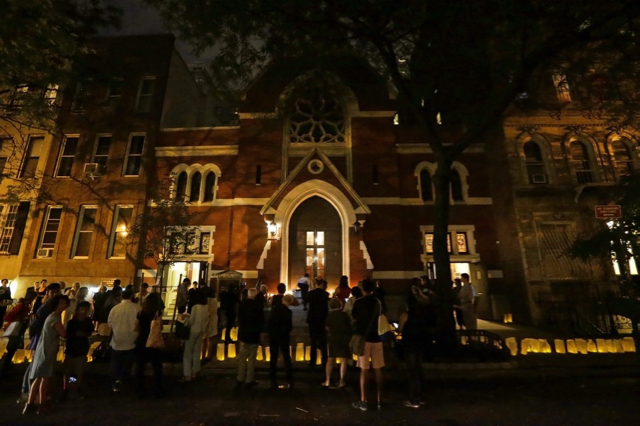
(Above) Candlelight vigil in front of the closed church of Our Lady of Peace. (Photo from http://olpchurchnyc.typepad.com)
Some interesting articles have appeared recently on this and allied issues.
First, Melanie Grace West in an article in the Wall Street Journal documents important procedural wins for a number of parishes appealing the Archdiocese’s decision to close them. In the case of at least two parishes, the Vatican specified that divine services were to continue in the building of the closed parish and that members of the parish had rights to worship there. In regard to a Polish ethnic parish in Poughkeepsie:
“In the case of St. Joseph, the amendment says, the building may be used for public and private worship. In addition, it is to be open for the feast celebration of the parish’s patron saint and its anniversary.
Finally, an amendment allows for all St. Joseph parishioners to formally become members of the newly merged entity.”
In regard to St. Andrew’s in Lower Manhattan, which was merged but not (yet) closed:
Joseph Canepa has led the appeals process for St. Andrew’s, a lower-Manhattan parish that was formally merged with Our Lady of Victory. St. Andrew’s serves primarily court officers and law enforcement, and while the merger didn’t completely close the parish, it did affect the frequency of Masses, he said.
It too benefited from a decision by the Congregation for the Clergy, which it received this month. The revised decree says that “the church of St. Andrew will continue to remain open to the daily access of the faithful and for the daily and Sunday celebration of Holy Mass with a regular schedule.”
The Congregation for the Clergy’s amendments to St. Andrew’s honor the unique membership of the parish, a decision Mr. Canepa called “a gift.”
Additional information has been requested by the Vatican in the case of five other parishes – including St Elizabeth of Hungary and Our Lady of Peace (both on the Upper East Side).
The blog of Our Lady of Peace has published the letter from the Vatican extending (once again) the time limit for reviewing the case until April 30, 2016. After receipt of the letter, the Our Lady of Peace community is “cautiously optimistic.”
The New York City Landmarks Preservation Commission has just taken action on a number of properties – including important Roman Catholic churches in Manhattan.
Prioritized for Designation:
St. Joseph’s Church at 401-403 West 125th Street
(One of the oldest churches in the North of Manhattan)
St. Paul’s Church and School at 121 East 117th Street
(Presumably this is St. Paul’s, the first Catholic parish in Harlem.)
Now David Gonzalez in the New York Times has written an article about another Roman Catholic church (Immaculate Conception in the Bronx) which been prioritized for landmark designation at this same meeting. The article summarizes the arguments the Archdiocese and religious orders always raise everywhere against Landmark designation. Allegedly this status adds to the cost of renovations and may prevent access ramps. It seems odd for an institution which spent $20 million on the restoration of St Bridget’s church and $171 million on St Patrick’s cathedral to complain about such costs. And landmark status is precisely designed to prevent owners from doing whatever they want with a given property – which is exactly what the Roman Catholic Church desires. Nowhere in this one-sided article is the most obvious issue mentioned: landmark status constitutes a barrier (even if surmountable under circumstances) to razing churches and selling the land. My conclusion is that landmark status is more important than ever, for as this article makes clear, the Roman Catholic Church itself sees artistic, historical and cultural merit as likely being in conflict with “a Church of the people.”
Related Articles
No user responded in this post